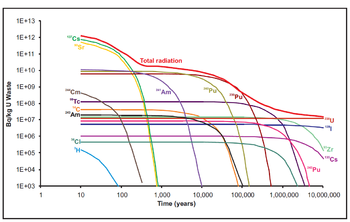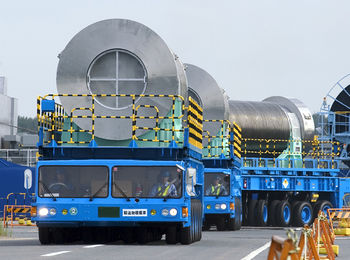Nuclear waste management: Difference between revisions
(→Reprocessing: add link to video on French recycling process) |
mNo edit summary |
||
| Line 26: | Line 26: | ||
==Reprocessing== | ==Reprocessing== | ||
{{Image|Vitrification.gif|right|350px|Fig.8 Fission products and other high-level waste remaining after reprocessing spent nuclear fuel may be melted into glass and cast into stainless steel canisters for permanent disposal.<ref>See [https://www.world-nuclear.org/information-library/nuclear-fuel-cycle/nuclear-wastes/treatment-and-conditioning-of-nuclear-wastes.aspx Treatment and Conditioning of Nuclear Waste] for more on the ultimate disposal of waste from reprocessing of nuclear fuel.</ref>}} | |||
*[https://www.world-nuclear.org/information-library/nuclear-fuel-cycle/fuel-recycling/processing-of-used-nuclear-fuel.aspx Processing of Used Nuclear Fuel] World Nuclear Association | *[https://www.world-nuclear.org/information-library/nuclear-fuel-cycle/fuel-recycling/processing-of-used-nuclear-fuel.aspx Processing of Used Nuclear Fuel] World Nuclear Association | ||
*[https://www.youtube.com/watch?v=V0UJSlKIy8g Recycling used nuclear fuel - Orano la Hague] video on the French recycling process<br> | *[https://www.youtube.com/watch?v=V0UJSlKIy8g Recycling used nuclear fuel - Orano la Hague] video on the French recycling process<br> | ||
| Line 34: | Line 36: | ||
==Permanent Disposal== | ==Permanent Disposal== | ||
After recovery of all the valuable isotopes in spent fuel, there will still be a small remainder of high-level waste. This can be easily and permanently disposed in deep geological repositories already in use for bomb production waste.<ref>See the document [https://wipp.energy.gov/pdfs/Why_Salt.pdf Why Salt] from the US Department of Energy.</ref> | After recovery of all the valuable isotopes in spent fuel, there will still be a small remainder of high-level waste. This can be easily and permanently disposed in deep geological repositories already in use for bomb production waste.<ref>See the document [https://wipp.energy.gov/pdfs/Why_Salt.pdf Why Salt] from the US Department of Energy.</ref> | ||
==Further Reading== | ==Further Reading== | ||
Revision as of 20:10, 9 August 2022
- See also: Nuclear_power_reconsidered
This article is intended to answer the questions raised in Nuclear power reconsidered.

How much waste is produced compared to other sources of energy? How will it be contained, and what are the dangers to people and the environment? Like questions on safety, public perception of the dangers of nuclear waste is much worse than historical data shows.[2] The volume of waste per per terawatt-hour is 100,000 times less than coal.[3] Even if we look only at radioactivity released to the environment,[4] watt-for-watt nuclear power is 100 times less than coal.[5]
Much of the worry about nuclear waste centers around the long life of some isotopes in the waste (See Fig.3). There is concern about leakage into the environment decades or even centuries from now. Billion-dollar efforts to bury the waste deep under a mountain have only heightened public fears. Dry-cask storage at the power plants has proven to be a safe but temporary solution.[6] This interim storage has the advantage of being able to recover the "waste" and use it in newer reactors that can use the remaining 95% of available energy.
Transportation of wastes from reactors to disposal or reprocessing sites must be done safely. Leakage into groundwater and ocean water near shore is a special concern. New reactor designs must address these concerns, even though they go beyond the design of the reactor itself. Will the waste be solid or liquid? Will it require special casks, or even special vehicles for transportation on public roads? (See Fig.4)
Other worries include the possibility of sabotage or theft of waste material that might be useful in a "dirty bomb". We should evaluate specific plans by considering likely scenarios. Is the storage facility away from any population center and not a target for an airplane crash, a truck bomb, or even a short-range missile? Is there a secure perimeter with intrusion detectors? If there is an intrusion, is cutting through the concrete and steel difficult enough that there will be plenty of time for a response from local law enforcement, or even a nearby military base? (See Fig.5)
In evaluating a new reactor design, we must look at the complete fuel cycle, not just the waste from the reactor itself. Are there any problems with the mining, processing, or transportation of the fuel, or with the reprocessing of spent fuel?
Interim Storage
It is important that we make a distinction between spent fuel from nuclear power, and the waste from bomb production, which was often done in a rush with little concern for pollution. Spent fuel rods can be stored safely. Weapons waste poses a much bigger problem due to the large variety and sometimes unexpected characteristics of the material to be stored.[8]
Reprocessing

Fig.8 Fission products and other high-level waste remaining after reprocessing spent nuclear fuel may be melted into glass and cast into stainless steel canisters for permanent disposal.[9]
- Processing of Used Nuclear Fuel World Nuclear Association
- Recycling used nuclear fuel - Orano la Hague video on the French recycling process
- 4000 employees, reprocessing Spent Nuclear Fuel for France and other countries
- Spent Nuclear Fuel: 95% U, 1% Pu, 4% fission products
- Vitrified waste volume 20% of original SNF volume, melted into stainless steel canisters
Permanent Disposal
After recovery of all the valuable isotopes in spent fuel, there will still be a small remainder of high-level waste. This can be easily and permanently disposed in deep geological repositories already in use for bomb production waste.[10]
Further Reading
Notes and References
- ↑ https://blogs.egu.eu/network/geosphere/2015/02/02/geopoll-what-should-we-do-with-radioactive-waste/
- ↑ “Over the last 40 years, thousands of shipments of commercially generated spent nuclear fuel have been made throughout the United States without causing any radiological releases to the environment or harm to the public.” - statement by the Nuclear Regulatory Commission quoted in Storage and Disposal of Radioactive Waste
- ↑ section 2.2 "A Beautifully Small Problem" in the book Why Nuclear Power has been a Flop.
- ↑ https://www.epa.gov/radtown/radioactive-wastes-coal-fired-power-plants
- ↑ https://www.scientificamerican.com/article/coal-ash-is-more-radioactive-than-nuclear-waste/ - The title is a bit misleading. From the article: "In fact, the fly ash emitted by a power plant—a by-product from burning coal for electricity—carries into the surrounding environment 100 times more radiation than a nuclear power plant producing the same amount of energy." "ounce for ounce, coal ash released from a power plant delivers more radiation than nuclear waste shielded via water or dry cask storage."
- ↑ Connecticut Yankee, a 619 MWe reactor on the Connecticut River, ran for 28 years between 1968 and 1996. The spent fuel from those 28 years is stored in 43 casks on a concrete pad, 70 feet by 228 feet.
- ↑ https://world-nuclear.org/information-library/nuclear-fuel-cycle/transport-of-nuclear-materials/transport-of-radioactive-materials.aspx
- ↑ A barrel containing plutonium mixed with kitty litter exploded days after it was "safely" stored at the Waste Isolation Pilot Plant, leading to "Nuclear accident in New Mexico ranks among the costliest in U.S. history" LA Times
- ↑ See Treatment and Conditioning of Nuclear Waste for more on the ultimate disposal of waste from reprocessing of nuclear fuel.
- ↑ See the document Why Salt from the US Department of Energy.



